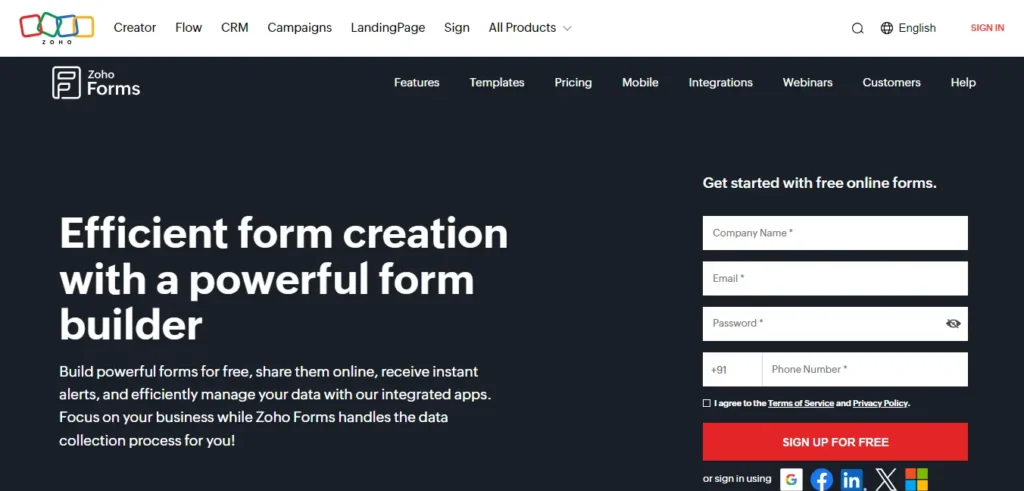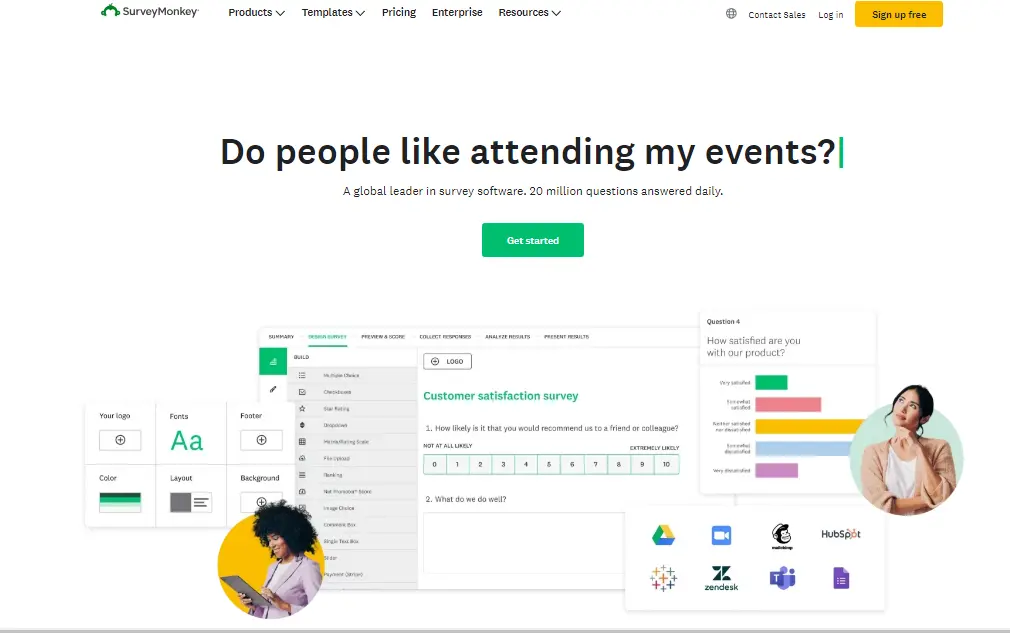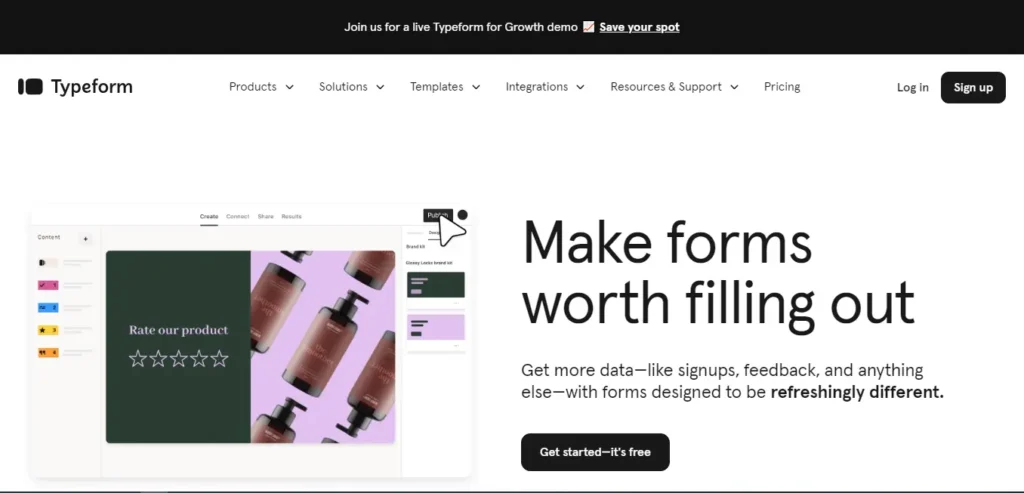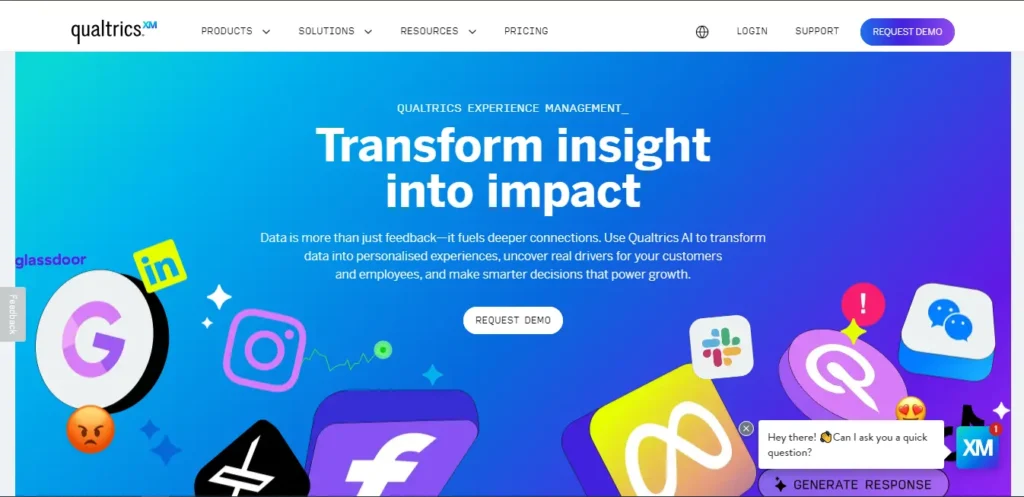A Step-by-Step Guide: Employee Satisfaction Survey

Employee satisfaction survey shows how your team feels. They reveal thoughts about their work and the company. They give insights into employee morale, job satisfaction, and workplace culture. This data shows where you can improve. It helps you boost productivity. It also increases job satisfaction.
Ask good questions, learn from answers, and make work better. Regular surveys help you understand your employees’ needs. This creates a positive and engaging workplace, helping you keep top talent.
A recent Statista, study found that companies with high employee satisfaction score more productivity in work compared to less satisfied employees. Which shows a 12% increase in it.
What is employee satisfaction?
Employee satisfaction is how happy an employee is with their job. It’s about their work environment and organization. It is influenced by many factors:

- Fair pay and good benefits significantly affect employee satisfaction. They get them for their work.
- Balancing work and life is crucial. It keeps employees satisfied.
- A good work environment promotes respect, open communication, and collaboration. It greatly boosts employee satisfaction.
- Employees who see chances for career and skill growth are more likely to be satisfied.
- Recognition and appreciation are crucial in motivating employees and increasing their satisfaction.
What is an employee satisfaction survey?
An Employee Satisfaction Survey is a formal questionnaire. It is used to gather employee feedback on their work experience. This includes their compensation, work-life balance, company culture, and leadership.

Here are some key benefits of conducting Employee Satisfaction Surveys:
- The survey results can help find areas for improvement in your company. They enable data-driven decisions to improve employee satisfaction.
- Seeking feedback can boost employee engagement. It shows a strong appreciation for their opinions. This leads to more ownership and commitment in the workforce.
- Addressing survey concerns can help create a positive work environment. It reduces employee turnover and retains top talent.
- Research shows a strong link between employee satisfaction and business success. A happy workforce boosts productivity, innovation, and customer satisfaction.
Why should you measure employee satisfaction?
You might be wondering. “Why do an Employee Satisfaction Survey?” A positive work environment, fueled by happy employees, is essential for a company’s long-term prosperity. Here’s a breakdown of the compelling reasons to measure employee satisfaction:

- Improved Business Performance: Research consistently shows a clear link between employee satisfaction and key business metrics. Satisfied employees are more productive, and engaged, and deliver better customer service. This translates to higher profits and a competitive edge for your company.
- Reduced Turnover: Employee turnover is a costly problem. A discontented workforce is more likely to seek employment elsewhere. You can use surveys to find and fix employee concerns. This will make a happier workplace and keep your valuable talent.
- Enhanced Decision-Making: Employee Satisfaction Surveys provide valuable data-driven insights into your workforce. You understand employee sentiment. You can use the data to make informed decisions. It’s about pay, benefits, work-life balance, and other factors. These things affect employee satisfaction.
- Boosted Employee Morale: When employees feel heard and valued, it leads to a more positive work environment. It also makes work more collaborative. Conducting surveys shows you care about their well-being. It shows you are committed to creating a good work experience.
- Early Identification of Issues: Employee Satisfaction Surveys can act as an early warning system.
Also, Read:
What are employee satisfaction survey questions?
Now you have already seen the importance of measuring employee satisfaction. Let’s talk about the practical steps:

Company Culture
- Do you perceive your contributions to be appreciated by the organization?
- Do you enjoy working with your colleagues?
- Is the company open to employee feedback and suggestions for improvement?
- How well does the company’s mission and values align with your own?
- Would you recommend this company as a great place to work?
Job Satisfaction
- How meaningful and challenging do you find your work?
- Do you feel you have the autonomy and resources to do your job effectively?
- Are your goals and objectives clear?
- Do you receive regular feedback and performance reviews?
- How are you liking your current role these days?
Work-Life Balance
- Do you feel you have a healthy work-life balance?
- Are you able to disconnect from work outside of office hours?
- Does the company offer flexible work arrangements to support your needs?
- How stressed do you typically feel at work?
- Is your workload manageable?
Compensation and Benefits
- Are you satisfied with your current compensation package (salary, bonus, etc.)?
- Do the company benefits meet your needs (health insurance, paid time off, etc.)?
- Do you feel your pay is competitive with the market rate for your position?
- Are there opportunities for raises and promotions within the company?
Management
- Do you feel your manager is supportive and provides clear direction?
- Does your manager value your contributions and provide opportunities for professional development?
- Is there open and honest communication between you and your manager?
- Does your manager create a positive and motivating work environment?
- To what extent does your manager’s leadership style empower you to do your best work?
Professional Development
- Does the company offer training and development? Will they help you grow in your career?
- Are you encouraged to attend conferences, workshops, or other learning opportunities?
- Do you feel your skills are being utilized and developed in your current role?
- Does the company offer clear career paths for your position?
Advantages of Conducting Employee Satisfaction Surveys
In today’s competitive job market, keeping your employees happy is critical. But how do you know what’s truly going on beneath the surface? Employee satisfaction surveys help you understand your staff. They show where you can improve. This can lead to better results for your company.
Here’s why you should consider adding employee satisfaction surveys to your HR toolkit:
- Get Unfiltered Feedback: Surveys let employees share their real thoughts privately. This helps them feel more comfortable. They can be honest, whether their feedback is positive or negative. This can uncover hidden issues that traditional one-on-ones might miss.
- Identify Areas for Improvement: Are employees feeling overloaded? Unclear on company goals? Surveys pinpoint specific aspects of the work environment that need attention.
- Boost Employee Engagement: Valuing their input shows you care. It lets them know you care about their well-being. This fosters a sense of trust and belonging, leading to a more engaged workforce.
- Reduce Turnover: Happy employees are less likely to leave. Surveys help you keep top talent. They do this by addressing concerns and building a positive work culture.
- Make Data-Driven Decisions: Surveys go beyond hunches. They give clear data to help with decisions on pay, benefits, and company culture. This makes it easier to choose the right strategies.
- Improve Communication: Surveys can reveal communication gaps between management and employees. By understanding these gaps, you can improve communication flow and transparency.
- Track Progress Over Time: Regular surveys allow you to measure the impact of changes you make. See if your efforts to improve satisfaction are paying off!
Best Practices for Employee Satisfaction Surveys
Employee satisfaction surveys offer valuable insights. But to get the most out of them, you need the right approach. Here are some tips to help your surveys provide useful data. These tips can also lead to positive changes:
- Define Your Goals: Before you start writing questions, know what you want to learn. Are you measuring overall satisfaction? Or are you looking at specific areas like work-life balance or professional growth?
- Target the Right Audience: Survey specific departments or groups. This gives a clearer picture.
- Keep it Short & Sweet: Employees are busy! Aim for surveys that take 15-20 minutes to complete.
- Mix it Up: Use different question types. Include multiple-choice, Likert scales, and open-ended questions. This gives you better feedback.
- Confidentiality is Key: Guarantee anonymity to encourage honest responses. Use a reputable survey platform that prioritizes data security.
- Pilot Test First: Test with a small group first. This will help find confusing questions or technical problems.
- Communicate Clearly: Explain the purpose of the survey and how the results will be used.
- Promote Participation: Make the survey accessible and user-friendly. Use various channels to reach employees. You can use email, the company intranet, or internal communication apps.
- Analyze & Act: Don’t just collect data! Look at the results. Spot any trends. Make a plan to address employee issues.
- Communicate Follow-up: Share key findings with employees. Outline your plan to address their feedback. This shows you’re listening and taking action.
- Regular Check-Ins: Run surveys regularly. This helps you track progress and see how changes affect results.
Top Employee Satisfaction Survey Tools
Employee satisfaction surveys help you measure engagement and find areas for improvement. They can also boost your bottom line. With so many survey tools available, choosing the right one can be tough. This guide covers the best options, from easy-to-use tools to advanced features. Discover how to get valuable insights and create a better workplace.
SurveySlack
SurveySlack is a modern tool for employee satisfaction surveys. It makes gathering feedback easy and helps boost engagement. SurveySlack works smoothly with your current communication channels. This makes it simple for employees to give their feedback and share their thoughts. We also have AI-Powered Survey Questions Generator.

Key Features:
- Launch and complete surveys directly within your Slack workspace, maximizing participation.
- Gather real-time feedback on specific topics with quick, bite-sized surveys.
- Guarantee confidentiality for honest and open employee feedback.
- View clear data visuals and reports. Spot key trends and find areas to improve.
- Compare your results to industry standards to see how you stack up.
- Go beyond multiple choice with open-ended questions to capture in-depth feedback.
- Tailor surveys to match your company branding for a seamless experience.
- Employees can access and complete surveys on any device, anywhere.
- Get instant insights as responses come in, allowing for quick action.
- Drill down into data by demographics, departments, or other relevant categories.
What You Will Love:
- Seamless integration makes participation effortless.
- Get clear insights to guide strategic decisions about employee well-being.
- Show employees you care by listening to their feedback.
- SurveySlack eliminates the need for expensive third-party tools.
- SurveySlack adapts to your growing company and evolving needs.
What You May Not Love:
- Branding is customizable. However, question types may be limited compared to more advanced survey tools.
- SurveySlack is a newer platform. As a result, it may have fewer user reviews than more established solutions.
Zoho Survey
Zoho Survey empowers you to hear your employees loud and clear. Build custom employee satisfaction surveys with ease, and gather valuable feedback directly.

Key Features:
- Effortlessly create professional surveys with a user-friendly interface.
- Engage employees with multiple choice, Likert scales, and open-ended questions.
- Uncover trends and actionable insights with clear data visualizations.
- Guarantee confidentiality to encourage honest employee voices.
- Distribute surveys via email, web links, or embed them within your company portal.
What You Will Love:
- Zoho Survey offers affordable plans to fit any budget.
- Grows with your business, accommodating surveys for small teams or large enterprises.
What You May Not Love:
- While user-friendly, some advanced features might require a bit of learning.
- Customization options might be less extensive compared to high-end survey tools.
Survey Monkey
SurveyMonkey is a top choice for online surveys. It provides a strong platform for collecting employee feedback.

Key Features:
- Get started quickly with industry-specific employee satisfaction templates.
- Create surveys that reflect your company culture for a professional look.
- Work together to build and analyze surveys for a streamlined process.
- Gain clear insights with data visualizations and customizable reports.
- Ensure confidentiality and encourage honest employee feedback.
What You Will Love:
- Easy to use interface makes creating and analyzing surveys a breeze.
- Adapts to your needs, suitable for small businesses and large enterprises alike.
What You May Not Love:
- The free plan has restricted features, requiring paid plans for advanced functionality.
- Customization options might be less flexible compared to specialized employee survey tools.
Typeform
Typeform changes how we do employee satisfaction surveys. It focuses on design and engaging interactions.

Key Features:
- Create visually appealing surveys that feel more like conversations than questionnaires.
- Ask relevant follow-up questions based on employee responses for a personalized experience.
- Gather rich qualitative data with features like text boxes and image uploads.
- Connect Typeform with your existing HR tools for a smooth workflow.
- Make the experience personal. Use employees’ names and add progress bars. This helps keep them engaged.
What You Will Love:
- The interactive format boosts participation and keeps employees interested.
- Collect more detailed data, not just yes or no answers. This helps you understand how employees really feel.
What You May Not Love:
- The free plan offers limited features and branding options. Paid plans are required for most functionalities.
- Customization options for question types may be more limited. They might not be as extensive as those in traditional survey tools.
Qualtrics
Qualtrics is a top player in survey software. It provides a full range of tools for detailed employee satisfaction analysis.

Key Features:
- Build complex surveys with branching logic and skip logic for a personalized experience.
- Go beyond basic satisfaction with tools to measure engagement and overall employee experience.
- Compare your results to industry standards and gain insights into workforce trends.
- Get clear, insightful reports with interactive data visualizations for easy communication.
- Qualtrics securely manages large datasets. It can scale to fit the needs of any organization, big or small.
What You Will Love:
- Unearth powerful insights with advanced features and robust analytics.
- Scalable platform adapts to your growing needs and evolving employee feedback requirements.
What You May Not Love:
- Complexity may require more training compared to user-friendly survey tools.
- Qualtrics caters to larger organizations with pricing plans reflecting its advanced features.
Common Mistakes to Avoid in Employee Satisfaction Surveys
Employee satisfaction surveys help you understand your workforce. But even with good intentions, mistakes can still happen. Here’s what to dodge to ensure your surveys deliver valuable data and lead to positive change:
- Unclear Goals: Before you start writing, know what you want to learn. Are you measuring overall satisfaction? Or are you focusing on specific areas like work-life balance or professional development? A clear goal keeps your survey focused and the insights actionable.
- Survey Overload: Nobody likes a long-winded survey! Aim for 15-20 minutes to keep employees engaged and get a good response rate.
- Confusing Questions: Double-barreled questions ask two things at once. This can confuse respondents. Vague wording can also lead to unclear answers. Both can result in messy data. Keep questions clear, concise, and easy to understand.
- Lack of Anonymity: Confidentiality is key! Employees won’t be honest if they fear repercussions. Guarantee anonymity to encourage open and honest feedback.
- No Follow-Up: Don’t just collect data and disappear! Share key findings with employees and outline a plan to address their concerns. This shows you’re listening and taking action.
- One-Size-Fits-All Approach: Tailor surveys for different departments or employee groups. This gives a clearer analysis. For example, managers might have different concerns than entry-level employees.
- Neglecting Mobile-Friendliness: Ensure your survey works on all devices. This includes smartphones and tablets. Busy employees might prefer to answer on the go.
- Limited Response Options: Don’t just rely on yes/no answers. Add options like ‘somewhat satisfied.’ You can also use open-ended questions. This helps get more detailed feedback.
- Skipping the Pilot Test: Test the survey with a small group first. This will help you find confusing questions or technical problems. Fix these issues before sending the survey to everyone.
Boost Employee Engagement
Learn what drives your team’s performance
Conclusion
An Employee Satisfaction survey is a must for every organization. It provides valuable insights into your workforce. It helps you design, distribute, analyze, and use the data from your survey. This data will help you create a better work environment for your employees. Remember, a satisfied workforce is the cornerstone of a successful organization.
Taking action on feedback shows your commitment to employee well-being. It sets your company on a path to lasting growth and success.





